#Personality Theory
Explore tagged Tumblr posts
Text


#mbti personalities#mbti#personality theory#16 personalities#healthy and unhealthy#infp#enfj#enfp#infj#intp#entp#istp#istj#intj#entj#estp#estj#personality traits#isfj#isfp#esfj#esfp
715 notes
·
View notes
Text
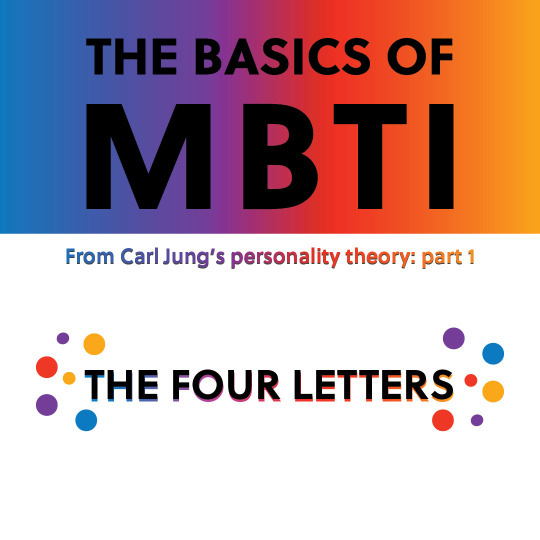

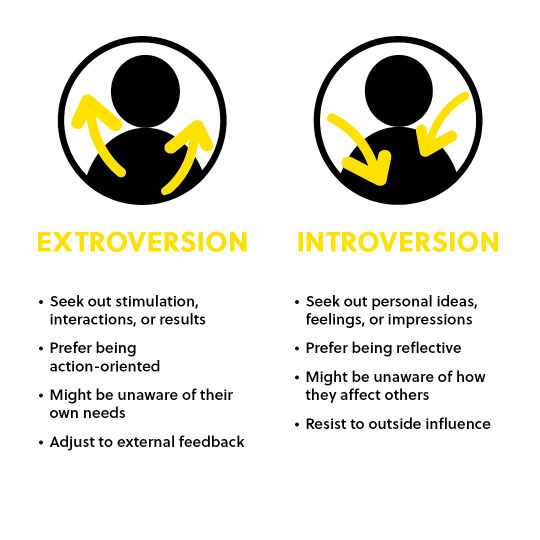




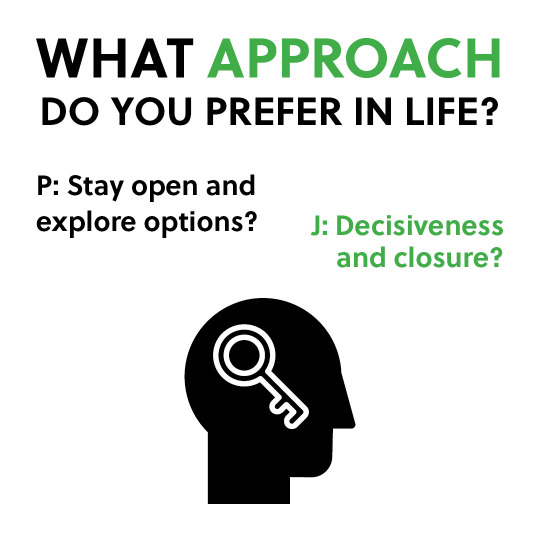



THE BASICS OF MBTI (from Carl Jung's personality theory - part 1)
THE FOUR LETTERS :
(E)XTROVERSION vs (I)NTROVERSION
(S)ENSING vs I(N)TUITION
(T)HINKING vs (F)EELING
(P)ERCEIVING vs (J)UDGING
-----
In the next post, we’re going to talk more in-depth about different categories of Intuition, Sensing, Feelings and Thinking called: Cognitive Functions.
#personality#personality theory#self growth#psychology#personality types#mbti#typology#carl jung#ESTJ#ESFJ#ESTP#ESFP#ISTJ#ISFJ#ISTP#ISFP#ENTJ#ENFJ#ENTP#ENFP#INTJ#INFJ#INTP#INFP#introvert#extrovert#sensing#intuitive#thinking#feeling
306 notes
·
View notes
Text

What Your Favorite Robin (might) Say About Your Personality:
A recent study found a statistically significant correlation between a group of subjects’ favorite fictional characters and self-reported scores on an assessment of five factor-personality traits. These five factor traits include extraversion, agreeableness, open-mindedness, conscientiousness, and neuroticism; with individuals being either on the high end of a given factor, the low end, or somewhere in-between (a more in depth review of the five factor model can be found here).
In the study, test subjects significantly tended to gravitate toward favorite characters who shared their same five factor profiles. For instance, those who might be on the high end in terms of agreeableness, low on open mindedness and high on neuroticism tended to most like characters who portrayed this same combination of factors.
Conversely, the traits of a given fictional favorite could potentially be illustrative of one’s own five factor personality model. By no means a scientifically rigorous analysis, but maybe a fun exercise nonetheless.
That said, what might your favorite Robin say about you?
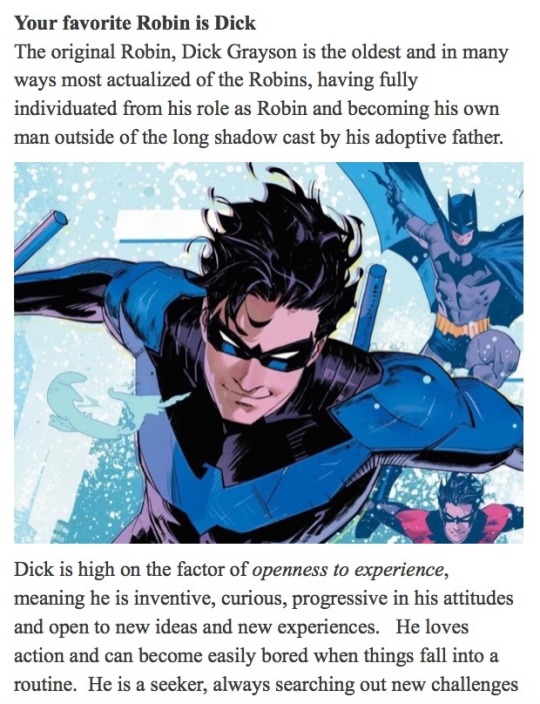
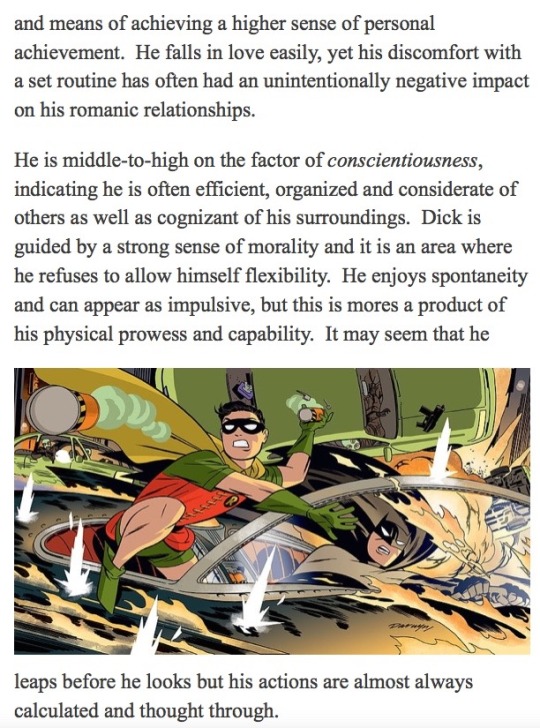
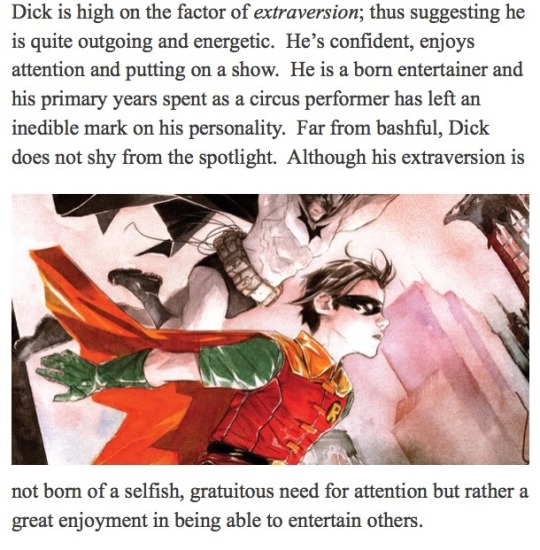

Is your favorite Robin Dick? And, if so, do you relate to the above personality traits, are these elements that you see in yourself or strive to achieve?
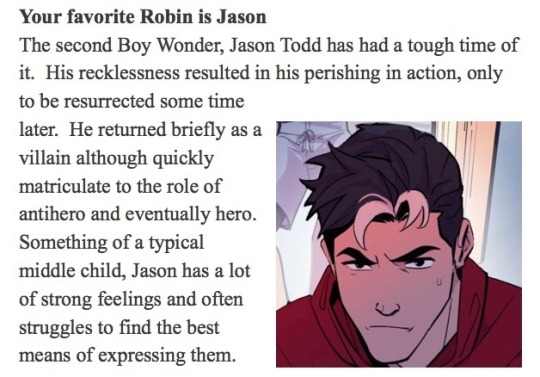

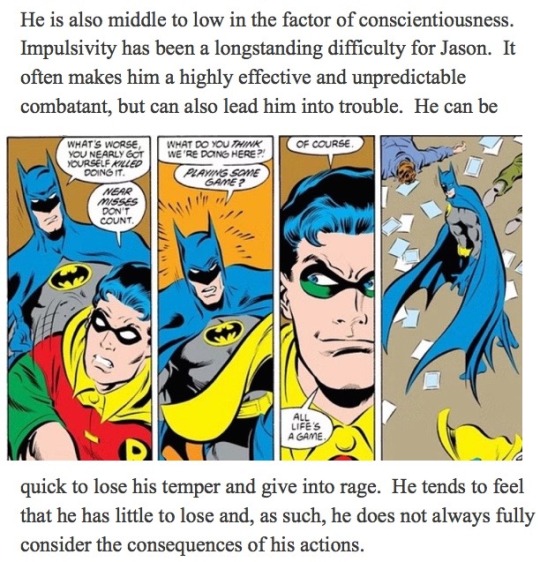
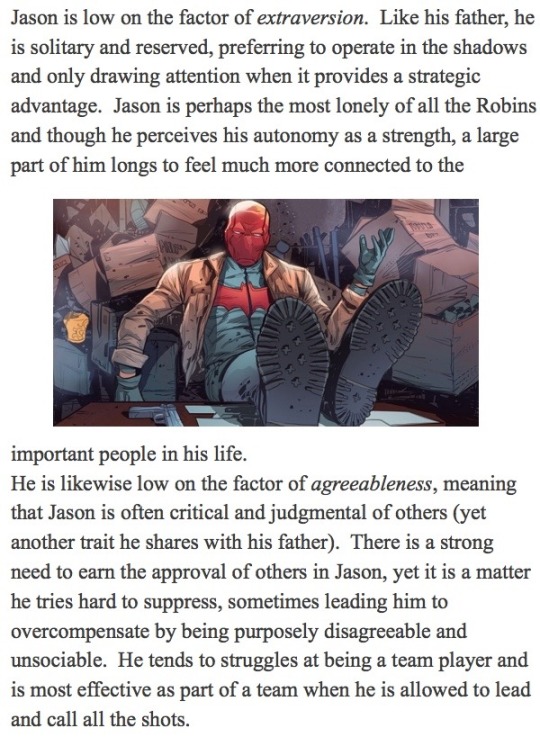
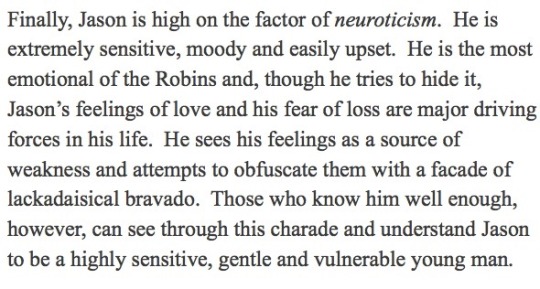
Okay... is Jason your favorite Robin? If this is the case do you relate to any of the the descriptors above?
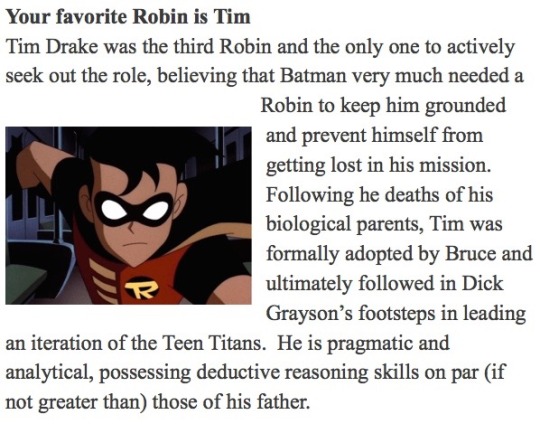
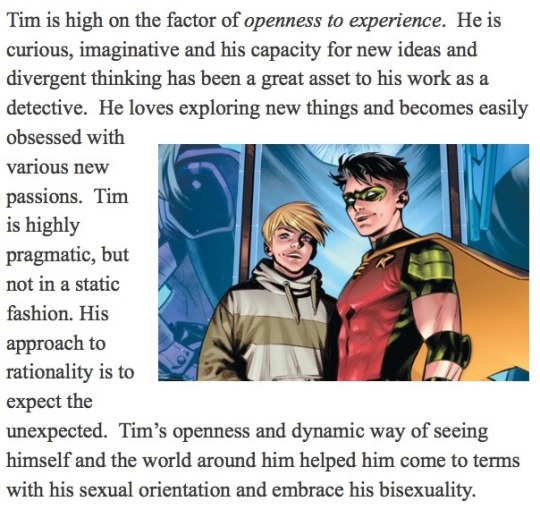
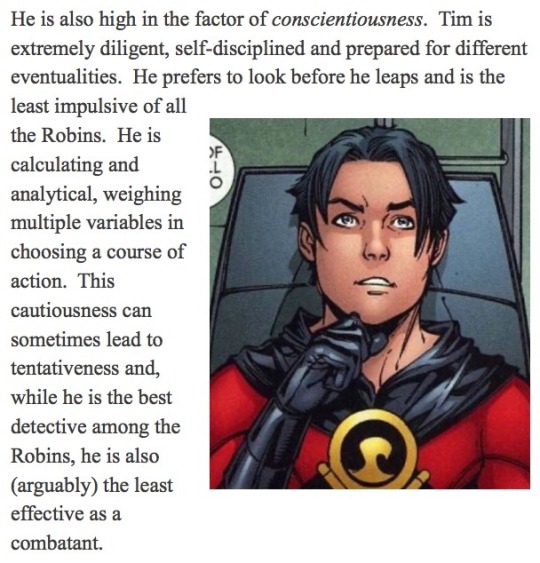
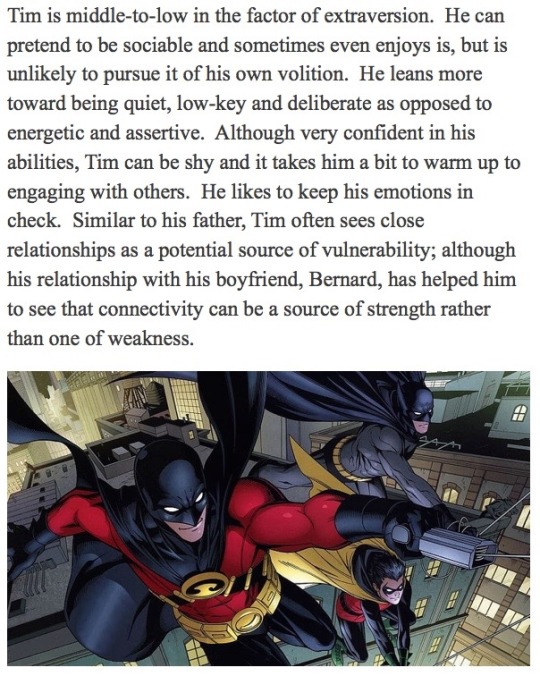

So, is Tim your favorite Robin? Do you relate or aspire to be more like the traits he possesses as listed above?
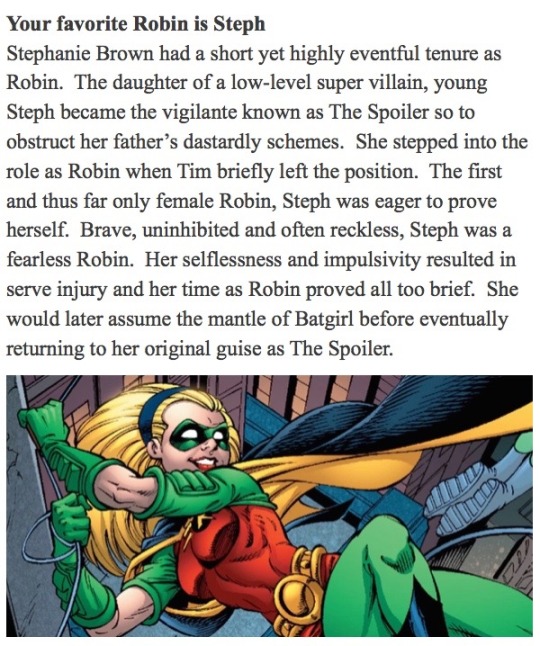
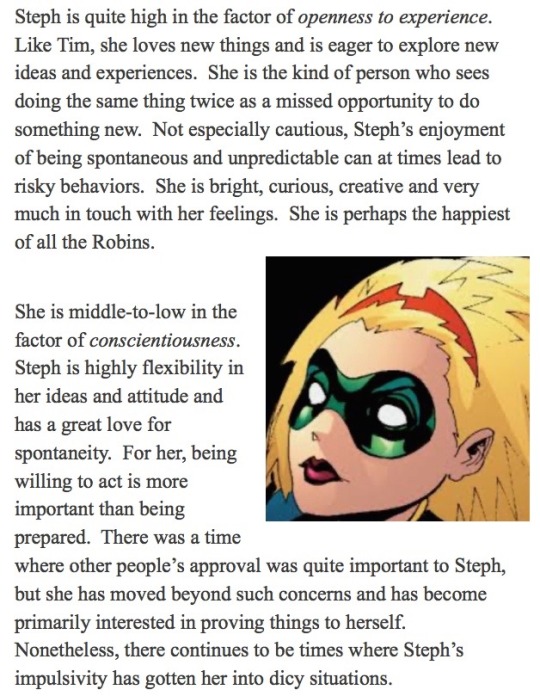
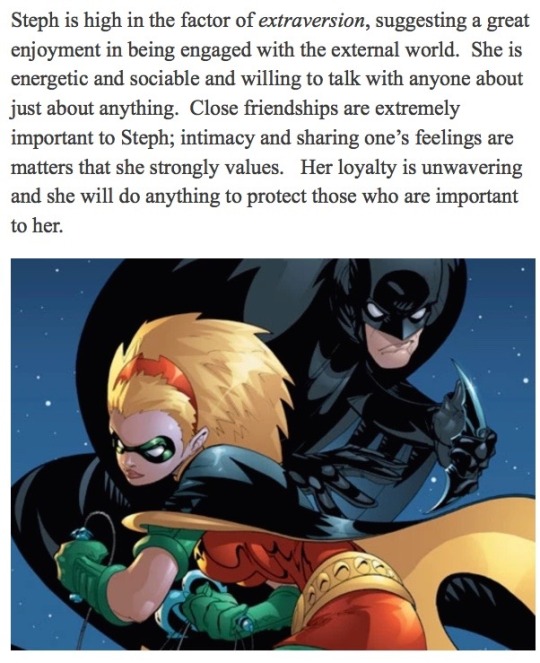
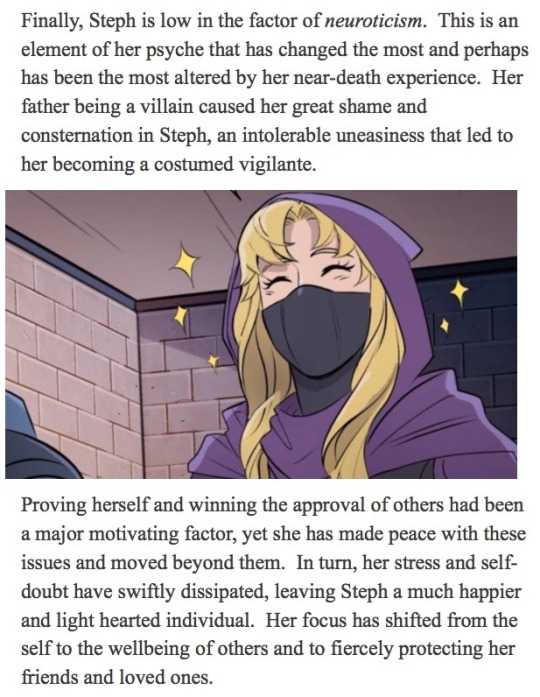
Now is Steph your favorite Robin? And if so do you identify with her on the characteristics as listed above?
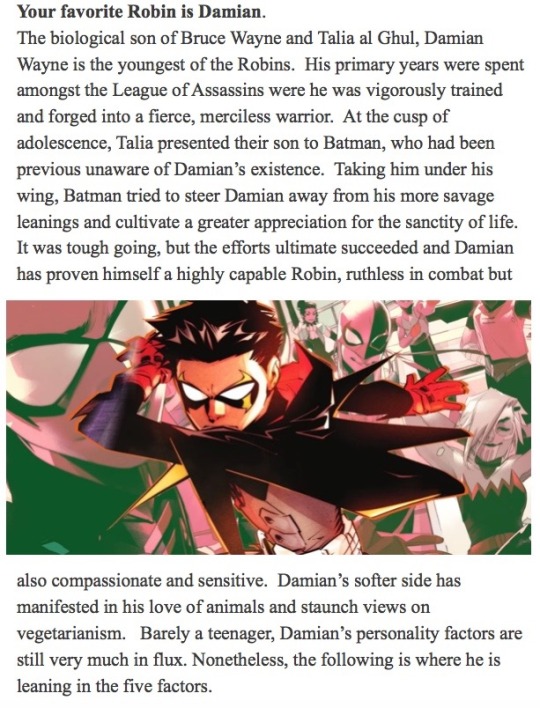
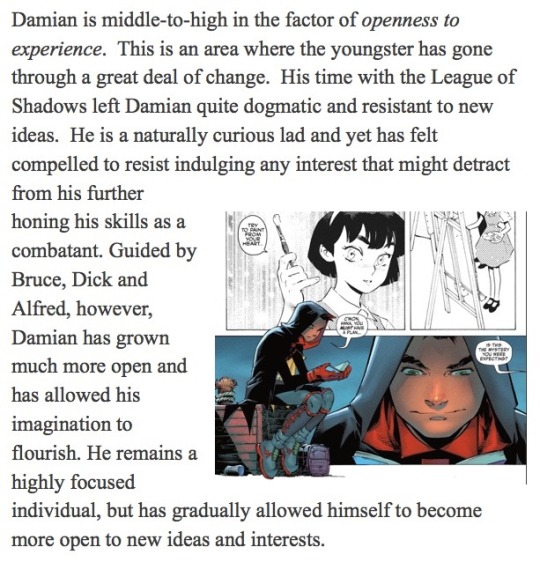
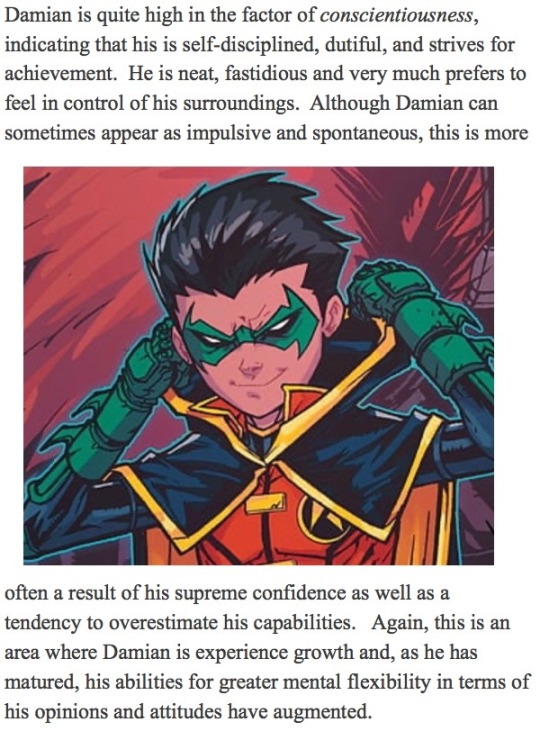
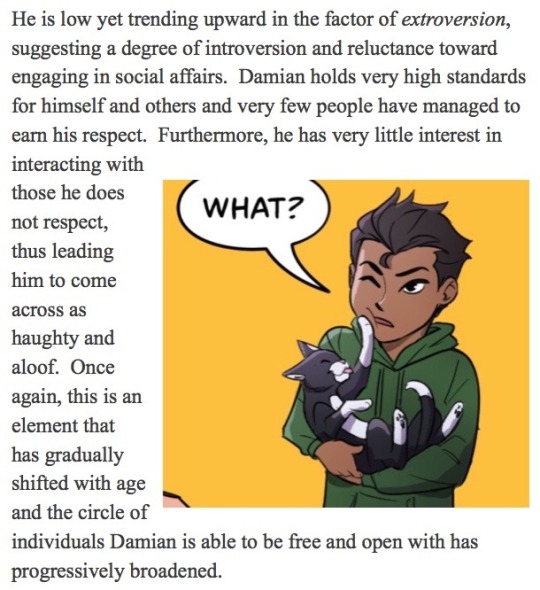

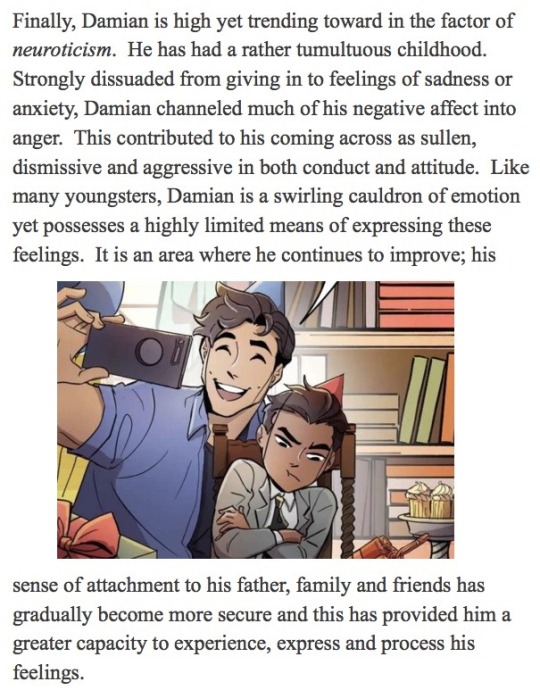
Alright... is Damian your favorite Robin? If so, can you relate to or feel a kinship with aspects of his journey?
The above of course is merely an exercise and should not be considered as a valid psychological assessment of personality. Still, it is an interesting notion and I'll be curious to hear anyone's thoughts or feelings on this matter.

#Batman#The Robins#psychology#personality theory#Dick Grayson#Tim Drake#Jason Todd#Damian Wayne#Steph Brown
69 notes
·
View notes
Text
what Ni is NOT
a lot of people in the community get Ni wrong. and i totally get that because Ni is often talked about in a super vague, weirdly prophetic light. which it is NOT.
Ni does NOT mean you can’t make connections between ideas
Ni does NOT mean you only see one truth
Ni is NOT a predictive function
all Ni is, is intuition as it makes sense to you personally. Ne, looks at the outside data and expands on that, Ni looks at the outside data and puts it in their internal framework. that’s the only difference. that Ni is personal and Ne is less personal when dealing with the abstract.
the combination of Se and Ni can come across as Ne because the user takes the tangible details and then subconsciously adds them to their mental framework. the way i personally decide between Ne and Ni is often based on this, idea. that Ni tends to be a more subconscious process, often with the user struggling to explain where the conclusion came from. Ne tends to be an obvious process. i have never once had to question where an Ne user got their idea from, because they often talk through their process unknowingly.
but just because you can’t fully understand it does NOT make Ni a sort of prophetic function. never was and never will be. it’s just the process of boiling physical things into concepts and adding said concepts to a mental framework that only makes sense to that specific person.
#mbti#mbti types#infj#introverted intuition#intj#mbti infj#personality theory#cognitive functions#typology#carl jung#myers briggs
304 notes
·
View notes
Text
9s
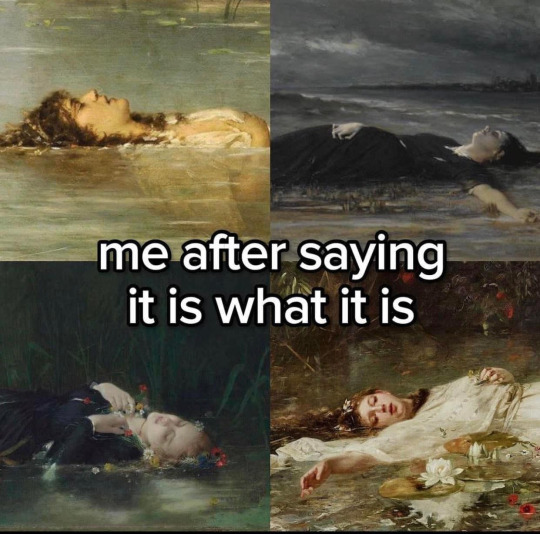
#enneagram 9#9w8#9w1#type 9#typology#enneagram#personality theory#8w9#1w9#withdrawn triad#optimist triad#positive triad#attachment triad
220 notes
·
View notes
Text
Enneagram system
A rewrite/more in depth post of the Enneagram system compared to my last post on it. Not an expert. May change later.
If you like kpop and typology, check out my blog. I do type analysis on idols and typology notes.
___
What is Enneagram?
I mainly took notes from Riso Hudson theory.
A typology system that categorizes personalities into 9 different types. Each type is numbered from 1 - 9.
Each type has a desire and fear that motivates their actions in life.
Core and Wings
Core: Our main type. It is the foundation of our personality and does not change.
Wing: Acts as a complement to our core. Wing can be one of the two types that sit beside core type. E.g a core 2 can have a 1 wing (2w1) or 3 wing (2w3). But is not necessary to use since wings can change and/or can be balanced.
Levels of Development
Summary of healthy - unhealthy levels of personality
- Healthy levels -
Level 1: Liberation
Let go of self image so we are free to express ourselves however we want. Self acceptance of all traits.
Level 2: Pyschological Capacity
Begin to identify with positive qualities in our personalities and learn to improve ourselves with them.
Level 3: Social Value
Still strongly identify with our set self image and make effort to maintain image. Want to share our good talents and abilities to make a positive effect on self and others.
- Average levels -
Level 4: Imbalance/Social roles
Idealization of self image; have a major focus on either good or bad qualities, no in between. Fear is an obstacle here.
Level 5: Interpersonal Control
Insist on self image being accepted by others, which can cause conflict. Can lead to controlling and manipulation.
Level 6: Overcompensation
Overcompensate due to underlying negative feelings. Desperate for others' acceptance.
- Unhealthy levels -
Level 7: Violation
Desperation for acceptance leads to violation of one's self and others. Serious conflict can occur. May victimize themselves to excuse offensive actions.
Level 8: Obsession and Compulsion
May be overly obsessed with an image of who they want to be. Deceives others
Level 9: Pathological Destructiveness
Most unhealthy state, display very toxic traits and behaviours, may have mental breakdown
Disintegration vs Integration
Or basically Stress vs Growth
Disintegration: When under heavy amounts of stress, a type will go into their disintegration type. They will pick up the negative traits of that type and act like the unhealthy version of it.
Integration: When maturing/developing positively, a type will go their integration type. They will pick up the positive traits of that type and improve their character.
___
* I will only give short descriptions for the triads. I will explain more in depth in individual posts.*
Centers of Intelligence
There are 3 centers of intelligence. Each center shows how and why we solve issues in life.
Gut/Instinct/Anger (types 1, 8, 9)
Gut center focuses on reacting and taking action immediately. This triad has an issue with control and anger.
1: Often perfectionists who repress their anger in order to remain morally good. They see their anger in a negative light.
8: The most open and comfortable with their anger. Uses it to assert boundaries, especially since this type fears vulnerability.
9: Often a passive type that dismisses or downplays their anger. They fear conflict and may worry being more assertive will cause a negative effect on themselves and others.
Heart/Image/Shame (types 2, 3, 4)
Heart center focuses on self identity and connections. This triad wants love and recognition and do what they believe is best to get that. They struggle with self worth.
2: They want to be needed and helpful to others. Pride themselves on being of service. Wants to receive love and to give love.
3: The most image oriented type. They always try to show their best selves and best efforts in order to seem admirable. Fears being worthless.
4: Wants to create a unique image for themselves, believes being boring will make them unloveable.
Head/Thinking/Fear (types 5, 6, 7)
Head center focuses on ideas, making rational decisions, and gathering info. This triad deals with fear and uncertainty.
5: The most internalized head type. 5's want to gather as much knowledge and resources as possible in order to stay secure and independent.
6: Quite an anxious type who seeks security through relations with others.
7: This type fears pain and suffering and seek out experiences in order to avoid negativity.
___
Other triads
- Harmonic Triads -
How types handle conflict, coping mechanism
Reactive (4, 6, 8)
Reactive types are not afraid to show and speak about their true feelings. They may seem "dramatic" in a way.
4: Melodramatic and self absorbed in negative feelings, drowns in intensity
6: Will argue, stick up for the right thing, moody, anxious
8: Big and loud reactions, can be very fiery
Positive (2, 7, 9)
Positive types dislike negativity and conflict and have their own ways of avoiding such tension. Optimistic during hard times.
2: Actively tries to be a good and kind person, only tries to focus on the good aspects of people
7: Seeks out fun opportunities to make their life exciting (basically distraction)
9: Values harmony and peace, will not risk any type of action that will disturb these values
Competency (1, 3, 5)
Competent types are often perfectionists who want to show their best selves. Objective and rational.
1: Strives to be correct and right, wants to be precise in what they do
3: Represses softer emotions to keep up a certain image, thrives with work/passions so they can be the best at what they do
5: Detached from feelings to remain logical and objective, knowledge seeking
- Hornevian Triads -
Relationships with others, how they get what they want
Assertive (3, 7, 8)
Assertive types go against people to get what they want. Do not back down easily, can seem aggressive and forceful.
3: Pushes through obstacles for achievements, goal oriented
7: Asserts their right to have fun, refuse to be restricted
8: Asserts power and strength, places boundaries
Withdrawn (4, 5, 9)
Withdrawn types are very internalized and do not show their needs openly. Deals with things alone.
4: Feels something is wrong with them internally, feels misunderstood
5: Detached from others as to not drain their own energy, will figure it out themselves
9: Introspective, lets life happen
Compliant (1, 2, 6)
Compliant work with people to get what they want. Builds relationships for security, wants to be helpful to others.
1: Doing the right thing instead of one's own wants
2: Focus on other's needs more instead of self
6: Tries to build a safe and secure environment by getting ppl to work together
- Object Relations -
How we are affected by others, our own affect on others, how we react to personal wounds
Attachment (3, 6, 9)
Seek out bonds and companionships for particular reasons. Individuality vs adaptation.
3: Changes their image to suit whoever they are with in order to meet expectations
6: Creates support systems to help with their self doubt and indecisiveness
9: Adapts to the energy of the environment to keep harmony
Frustration (1, 4, 7)
Triad gets frustrated when their needs aren't met.
1: Has a need to improve every little imperfection they find
4: Dislikes shallowness, longs for depth and complexity
7: Not enjoying experiences, not feeling fulfilled
Rejection (2, 5, 8)
Their own needs feel unimportant to others, so they reject their own needs as well.
2: Rejects the need to receive love and guidance, instead focuses on connecting with others and helping them.
5: Ignores and minimizes all their needs, offers knowledge and expertise in some hope of being acknowledged for their intelligence.
8: Rejects by being never putting their guard down, wanting to appear strong and as the protector of others.
___
Subtypes
Claudio Naranjo theory
There are three subtypes/instinctual variants that show our drive in life. There are 27 different subtypes in total.
Self Preservation (Sp)
Focuses on physical safety and security. Our physical health, financial security, obligations, and comforts.
Sexual/One - on - one (Sx)
Wants intensity and deep connections, one on one relationships are preferred.
Social (So)
Prefers to be in a community, wants to create good connections and bonds with others. Socially aware, focus on group goals and contributions.
___
Tritype
Katherine Fauvre theory
A minor but still interesting piece of Enneagram. Tritype is formed of your 3 dominant types from each center. The first number will always be your core, followed by your other 2 dominant types.
E.g 369. 3 = core, heart. 6 = head. 9 = gut.
___
Enneagram notes
___
Side blog:
Kpop astrology @rainy-astrology
Kpop fanarts @rainy-artworks
#enneagram#enneagram types#typology#mbti#enneagram notes#tritypes#triads#enneagram triads#instinctual variants#subtypes#enneagram personality#personality theory#enneagram 1#enneagram 2#enneagram 3#enneagram 4#enneagram 5#enneagram 6#enneagram 7#enneagram 8#enneagram 9#integration#disintegration#stress#growth
205 notes
·
View notes
Text
Controversial Opinion
What’s the obsession with enneagram 4? I genuinely don’t get why there are so many people so obsessed with this type.
I get that there are some people that just romanticizes some of the mental illness aspects of them HOWEVER mental illness isnt an inherent E4 thing and neither is personal struggle I can see why they correlate that to 4s (maybe cuz of the pseudo depression naranjo described on his work however thats just a false image they portray so?) , which mostly stems from terrible understanding of the type. However the increase in mistypes? The obsession with the SX4 subtype? The obsession with the toxic aspects of E4? Idk I just don’t get it.
I’m asking from a place of genuine wonder cuz this has been going on for a long time. And I want some clarity as to why it happens.
#mbti#zodiac#zodic signs#16 personalities#ennegram#personality types#mbti personality types#enneagram#typology#personality typology#enneagram 4#4w3#4w5#sx/so#so/sx#sp/so#sp/sx#so/sp#personality database#personality theory#personality tests#personality traits
140 notes
·
View notes
Text
Fe as a base (1st) function (ESE and EIE)
The individual is always in tune to the emotional flow surrounding him, and responds to it spontaneously and directly. He seeks out and creates activities where people are totally engaged in what they are doing. Something’s value is directly tied to how much it arouses his or another’s passion.
He is highly proactive about steering the emotional flow in the direction he himself considers ideal to a given situation. He may, for example, try to cheer people with jokes if he sees that they are too gloomy or, conversely, to get people to be serious and concentrated if they are too carefree during a crisis situation. Nevertheless, he believes emotions should be expressed as honestly as possible.
Fe as a creative (2nd) function (SEI and IEI)
The person is sensitive to the emotional atmosphere around him, either from an individual, or a group, or even from inanimate objects such as the landscape, the state of the physical environment he happens to be in, or his own emotional associations with the place or people around him. A positive emotional atmophere is essential for his sense of well being and inner peace, and he either tries to promote it himself by directly influencing it around him, or by simply moving away from the environment or the people causing a negative emotional environment in his view.
For the SEI, this takes an on-the-spot aspect and is reflected in cracking jokes, trying to make people laugh, or simply moving away from people he perceives as affecting him negatively. For the IEI, this takes a longer-term perspective; so the focus, rather than being on the immediate emotional environment, is on the perceived longer-term emotional state of others towards the individual, and is reflected in trying to be on good terms with those he interacts with or seeking distance or protection from, or “preventively” attacking, those he sees as irremediably hostile emotionally.
Fe as a role (3rd) function (LIE and LSE)
The individual makes an effort to adapt to the prevailing emotional atmosphere, especially in group situations, and tries to promote a positive emotional environment, as in making positive or witty remarks, in the presence of individuals he is already somewhat acquainted with and appreciates. Such efforts, however, are normally low-key and of short duration; it is difficult for him to display emotions more complex or intense than enthusiasm. He is essentially unable to participate in a group atmosphere where intense emotional expression as in loud laughing and mutual jokes are prevailing. The individual makes an effort to be aware of the need not to disrupt the prevailing emotional atmosphere but he does not succeed for any length of time if that would clash with his inner emotional state and private feelings about the other persons present. A typical example is the person who, in a group of people exchanging pleasantries and casual conversation, will occasionally correct erroneous statements made by others, in a way that can be perceived as annoying, despite otherwise making an effort to abide by the prevailing emotional atmosphere.
Fe as a vulnerable (4th) function (ILI and SLI)
The individual tries hard to never let himself “come apart at the seams” emotionally or even let out strong feelings publicly, because displays of passion do not come naturally and make him feel self-consciousness and vulnerable to painful criticism. This makes the individual generally seem emotionally neutral and politely indifferent to excitement and agitation around him. The individual deeply dislikes attempts by others to get him to “cheer up” or “join the fun”, especially in the context of group activities with loud emotional expression.
Fe as a suggestive (5th) function (LII and LSI)
The individual often becomes engrossed in serious work, which leads him to neglect his complementary need for fun and emotional release. He also feels vulnerable expressing himself spontaneously in public, which allows bad emotions and stress to build up, leading to depression or sudden hostility. He enjoys being around people who make him feel comfortable expressing himself, and who can make every day new and exciting.
Although he may present a hard exterior in the company of strangers, he is likely to not be serious at all with people who know him better. His behavior changes radically - a calm and serious structured person will suddenly become jovial and warm.
Fe as a mobilizing (6th) function (ILE and SLE)
The individual longs for situations where people are having fun, laughing and joking, and feel emotionally free and spontaneous. However, he is generally unable to produce this atmosphere himself and uses other means to create situations where there is a good chance that others will take the emotional initiative and create a fun and emotionally stimulating atmosphere. Failure at such attempts are met with dismay, which the individual either hides or reacts to with frustration and annoyance.
Fe as an ignoring (7th) function (ESI and EII)
The individual is perfectly able to integrate in a group emotional situations, such as people having fun and trading jokes, and sustain that for a long period of time. He is also usually adept at promoting such an atmosphere himself. However, he sees no point in doing so if his own inner emotional state does not prompt him towards that, especially if he does not feel as having positive private feelings towards the other people involved. He is aware of the need to keep a “polite façade” in certain social situations even in the presence of people he personally dislikes or during periods of negative inner emotions, but he refuses to actively attempt to integrate in, or promote, a positive external emotional atmosphere in such occasions. His disinclination for doing so increases along with his feelings of closeness with the individuals present.
Fe as a demonstrative (8th) function (SEE and IEE)
The individual appreciates situations where people are enjoying a positive emotional atmosphere as in having fun and joking together, and is quite adept at creating them himself, but does not see creating or promoting them a top priority, nor does he actively look for people who maintain or need such an atmosphere; too high a focus on that is seen by the individual as overdone.
Source: Wikisocion
52 notes
·
View notes
Text
Theories of Personality
Theories of personality aim to explain how and why individuals differ in their patterns of behavior, thinking, and emotions. There are several major theories that attempt to describe and categorize personality traits and development.
1. Psychoanalytic Theory (Sigmund Freud)
Core Idea: Freud’s theory of personality revolves around the interaction of the id (basic instincts), ego (rational thought), and superego (moral standards). He believed that personality develops through early childhood experiences and unconscious conflicts.
Structure of Personality: Freud proposed that the unconscious mind plays a key role in shaping behavior and personality, with unresolved internal conflicts influencing behavior.
Defense Mechanisms: Freud also suggested that individuals use defense mechanisms, such as repression or denial, to cope with anxiety and protect their self-image.
Stages of Development: The theory includes psychosexual stages (oral, anal, phallic, latency, and genital stages), with conflicts at each stage influencing adult personality.
2. Humanistic Theory (Carl Rogers, Abraham Maslow)
Core Idea: Humanistic theories emphasize personal growth, free will, and self-actualization. These theories view humans as inherently good, striving to reach their full potential.
Self-Actualization: Maslow's Hierarchy of Needs posits that individuals move through a series of needs, from basic physiological needs to self-actualization, where they fulfill their potential and experience personal growth.
Carl Rogers’ Person-Centered Theory: Rogers introduced the concept of the self-concept, which is how people perceive themselves. He believed that for individuals to achieve their full potential, they need an environment that provides genuineness, acceptance, and empathy.
Unconditional Positive Regard: Rogers argued that receiving unconditional love and acceptance is key to developing a healthy personality and self-esteem.
3. Trait Theory (Gordon Allport, Raymond Cattell, Hans Eysenck)
Core Idea: Trait theories suggest that personality is made up of broad, enduring traits or characteristics that determine behavior.
Gordon Allport: He identified three types of traits: cardinal traits (dominant traits that define an individual), central traits (general traits that form the basic foundation of personality), and secondary traits (more specific traits that appear in certain situations).
Raymond Cattell: Cattell used factor analysis to identify 16 personality factors, suggesting that a combination of these factors defines a person’s unique personality.
Hans Eysenck: Eysenck's model focused on three dimensions of personality: extraversion-introversion, neuroticism-stability, and psychoticism (related to aggressiveness and antisocial tendencies).
4. The Big Five (Five-Factor Model)
Core Idea: The Big Five personality traits are the most widely accepted framework for understanding personality. These traits are thought to exist along a continuum, and people fall at different points within these five dimensions:
Openness to Experience: Creative, curious, open to new ideas vs. traditional, routine-oriented.
Conscientiousness: Organized, responsible, goal-oriented vs. careless, impulsive.
Extraversion: Sociable, outgoing vs. introverted, reserved.
Agreeableness: Cooperative, compassionate vs. antagonistic, competitive.
Neuroticism: Emotionally unstable, anxious vs. emotionally stable, calm.
This model is considered to capture the basic structure of personality across different cultures and contexts.
5. Social-Cognitive Theory (Albert Bandura)
Core Idea: Personality is shaped by the interaction between personal factors (cognitive abilities, beliefs, emotions), behavior, and environment. This is known as reciprocal determinism.
Self-Efficacy: Bandura introduced the concept of self-efficacy, which is the belief in one's ability to succeed in specific situations. High self-efficacy leads to more persistence and confidence in challenging tasks, while low self-efficacy can lead to avoidance of difficult situations.
Observational Learning: Bandura also emphasized the role of modeling and observational learning in personality development, arguing that people learn behaviors and emotional responses by observing others.
6. Behaviorist Theory (B.F. Skinner)
Core Idea: Behaviorists argue that personality is the result of learned behaviors, shaped by rewards and punishments in an individual's environment.
Operant Conditioning: Skinner focused on operant conditioning, where behavior is influenced by reinforcement (positive or negative) or punishment. Over time, individuals develop consistent behavioral patterns based on their experiences with rewards and consequences.
Environmental Determinism: Behaviorists view personality as a product of the external environment rather than internal traits or unconscious forces.
7. Biological and Evolutionary Theories (Hans Eysenck, David Buss)
Core Idea: Biological theories emphasize that personality traits have genetic underpinnings and that human behavior is influenced by evolutionary processes.
Eysenck’s Biological Basis of Personality: Eysenck proposed that personality traits like extraversion and neuroticism are linked to biological differences in brain arousal and functioning.
Evolutionary Psychology: David Buss and other evolutionary psychologists argue that personality traits evolved to solve problems related to survival and reproduction. For instance, traits like aggression or cooperation may have developed as adaptive strategies in human evolutionary history.
8. Cognitive-Behavioral Theory
Core Idea: This theory integrates elements from both cognitive and behavioral psychology. It suggests that cognitive processes (thought patterns, beliefs) play a crucial role in determining behavior and, therefore, personality.
Aaron Beck’s Cognitive Theory: Beck emphasized how automatic thoughts and cognitive distortions (like overgeneralization or catastrophic thinking) shape personality and emotional responses.
Cognitive Restructuring: In cognitive-behavioral therapy (CBT), individuals learn to identify and change negative thought patterns, which in turn influences their behavior and personality over time.
9. Narrative Identity Theory
Core Idea: Narrative identity theory suggests that individuals construct a life story or narrative to make sense of their experiences and define their identity. This narrative evolves over time, reflecting personal growth, values, and social influences.
Dan McAdams: McAdams proposed that personal identity is shaped by the stories we tell about ourselves. People seek coherence and meaning in their life stories, which reflect their personality traits, goals, and values.
This approach emphasizes that personality is not just a set of static traits but an evolving narrative shaped by personal choices and experiences.
10. Existential and Phenomenological Theories
Core Idea: These theories focus on individual experience, freedom, and the search for meaning. Existential psychologists like Rollo May and Viktor Frankl argue that personality is shaped by how individuals confront fundamental existential questions, such as the meaning of life, freedom, and death.
Frankl's Logotherapy: Viktor Frankl emphasized the importance of finding meaning in life, even in suffering, as the central drive in human behavior. He believed that the quest for meaning shapes personality and behavior.
Authenticity and Choice: Existential psychology stresses that individuals are responsible for their own choices, and living authentically means confronting existential realities and making choices in alignment with one’s values.
Theories of personality offer different perspectives on the factors that shape human behavior and individual differences. From Freud’s focus on unconscious drives to the modern trait theories like the Big Five, these approaches explore the intricate dynamics of behavior, thought, and emotion that constitute personality.
#philosophy#epistemology#knowledge#learning#education#chatgpt#psychology#Personality Theory#Psychoanalysis#Humanistic Psychology#Trait Theory#Big Five#Social-Cognitive Theory#Behaviorism#Cognitive Theory#Evolutionary Psychology#Narrative Identity
14 notes
·
View notes
Text
tumblr dot com is the place where each Enneagram type comes to be the most insufferable version of ourselves
#said lovingly#enneagram#enneatypes#personality types#tumblr#tumblr culture#typoglogy#personality theory#1w9#1w2#2w1#2w3#3w2#3w4#4w3#4w5#5w6#5w4#6w5#6w7#7w6#7w8#8w7#8w9#9w8#9w1
47 notes
·
View notes
Text

Dealing with Misinformation in Typology Communities: A Case of Correcting Jungian Misunderstandings
In any field, especially one as complex as typology and psychology, there will always be room for misunderstanding. As individuals working to educate others or share insights, it’s often our responsibility to challenge misinformation with facts and resources. However this process doesn’t always go smoothly, and sometimes, even when our intentions are clear, our attempts to help can be misconstrued.
The Challenge of Educating in Online Communities
Typology, particularly systems like Jungian psychology, can be incredibly intricate and misunderstood. When a person offers a correction or clarification to a popular yet inaccurate belief, it's not uncommon for some to take it personally, or worse, dismiss it entirely. This can lead to instances where educational answers are flagged or dismissed as "spam" or "overbearing" despite the fact that they are trying to share valuable insights.
The Complexity of Online Moderation and Misinterpretation
In online communities, moderation systems often rely on algorithms or community flagging to detect spam and inappropriate content. While these systems are designed to filter out truly harmful material, they can sometimes misunderstand the context of a well-intentioned, educational post. When a correction is paired with external resources, such as links, it may trigger automatic spam filters, even though the intention was never to promote unrelated content, but rather to further clarify and support a point.
In a recent experience, a well-reasoned response correcting a widespread misunderstanding of Jung’s work was dismissed — not for being wrong, but for being too rigorous for the system to parse.
The Importance of Providing Value in Corrections
When we correct misinformation, especially in a complex subject like typology, our primary goal should always be to add value. This involves more than just pointing out to someone they are wrong; it’s about offering a thoughtful explanation—and invite deeper understanding.
In my case I included a couple of links to further emphasize my points—resources that could benefit others interested in the subject. Ironically the very links included to support clarity and learning appeared to trigger automated pushback — as though educational depth itself were suspicious.
This highlights a larger issue: how platforms moderate content. Even well-meaning posts can be flagged if the moderator (or algorithm) doesn’t fully understand the context or the educational nature of the response.
Moving Forward: The Need for Better Communication and Understanding
This experience has reinforced for me how important it is to approach online discussions with patience and a focus on clarity. It also emphasizes how crucial it is for platforms to refine their moderation systems, to better differentiate between spam and well-meaning educational content.
In the end, the goal should be to ensure that people can engage in constructive discussions — without fear of their content being unfairly flagged or misunderstood.
Conclusion
As I continue to navigate these challenges, I remain committed to contributing valuable insights into the world of human nature. I hope that, moving forward, platforms can become more adept at distinguishing between different types of content and foster a space where educational corrections can flourish without unnecessary obstacles.
© 2025- present Alessio David Ricioppo Parra (The Enneamentalist). All rights reserved. Insight isn't spam™.
#jungian psychology#typology#carl jung#personality theory#depth psychology#mindset#human nature#enneagram#mbti#social media#critical thinking
3 notes
·
View notes
Text
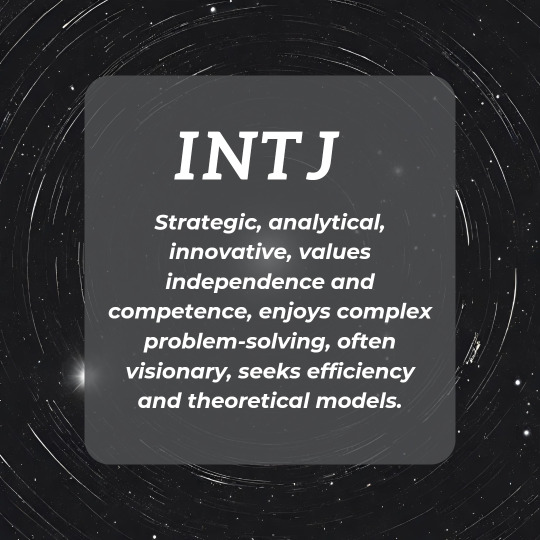
#intj#introvert#intuitive#thinker#intuitive thinker#judger#mbti#personality theory#personality#introverted intuition
87 notes
·
View notes
Text
ALL ENNEAGRAM TYPES AS DOGS
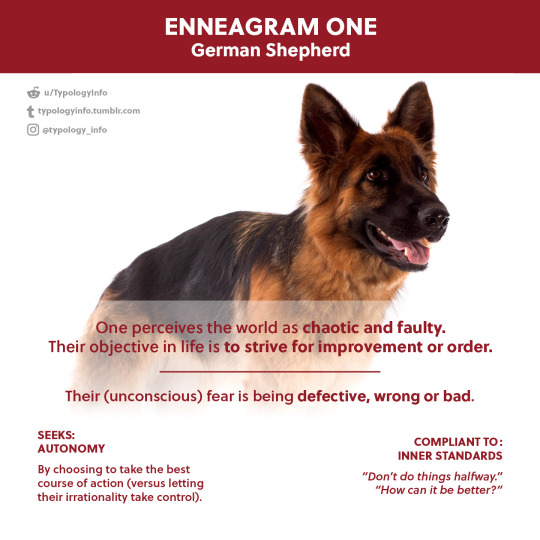




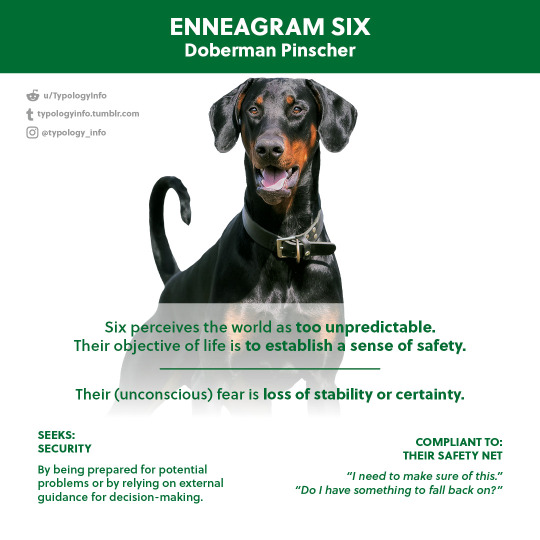
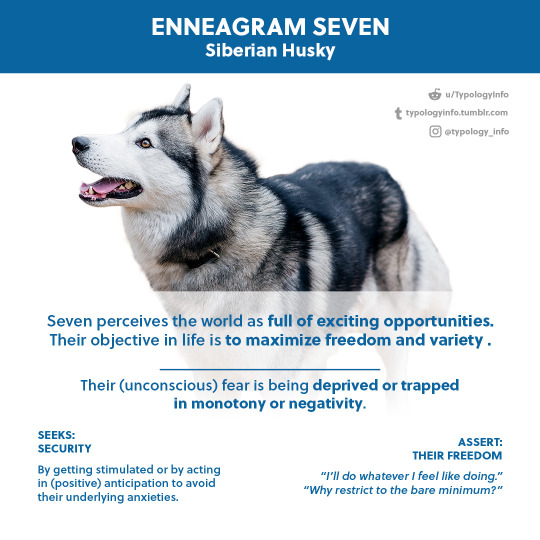

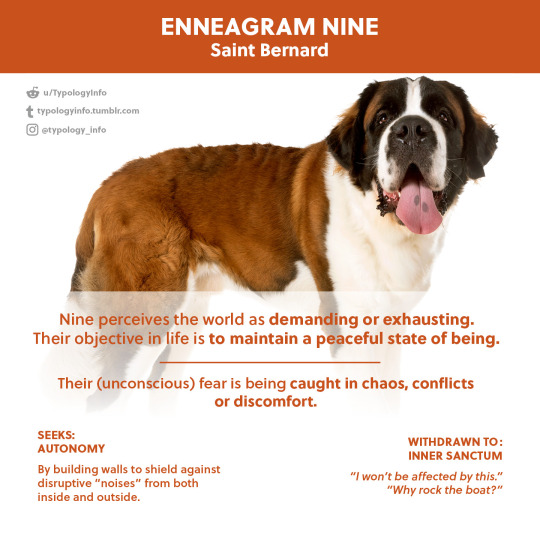
Ever wondered what each Enneagram type would be like as a dog? Here's a quick breakdown of their type ! 🐕
Want to dive deeper into each type? Check them out here : One / Two / Three Four / Five / Six Seven / Eight / Nine
I'm curious : tag your type and let me know if the description fits!
#enneagram#psychology#typology#personality#personality theory#spirituality#self growth#dog#personality types#1w9#1w2#2w1#2w3#3w2#3w4#4w3#4w5#6w5#6w7#7w6#7w8#8w7#8w9#9w8#9w1#5w4#5w6
111 notes
·
View notes
Text
The Meta Nature of Type 9
It seems to me that what 9 represents is the goal toward which all of the types strive when viewed from the outside looking in, i.e., through a general, non-specific lens — it is the goal of actualization, to become who we are in potentia; to awaken from the sleep of unconsciousness. Jung once remarked, "Laziness is the greatest passion of mankind, even greater than power or sex or anything," testifying to the likewise general (common-to-all) nature of 9's passion — Sloth. True to form, 9 is fixated on the (general) container, not the (specific) content, hence the non-representational character of its goal, this being the sine qua non of its capacity to contain, as it were, all content. This general goal is implicit in the question: "How can I be in my personality (ego) and in my Essence (Holy Virtue) at the same time?" In other words, how can I be one-in-myself? For all of the types bar 9, it seems that the goal is to harmonize personality with a content-based Essence, such as that of Depth (as in 4), Love (as in 2), Integrity (as in 1), so on and so forth. The goal for 9, however, is seemingly to harmonize personality with the Essence of harmony itself — a fetal-like curling back on oneself, a fetal-like non-duality (which, of course, it claims prematurely). It is, in this sense, identified with the universal container, without "personal" content because "transpersonal."
#enneagram#enneagram type 9#enneagram 9#enneagram type 9w1#enneagram 9w1#personality typology#personality theory
6 notes
·
View notes
Text
Introduction to Aesthetic Aspiration Personality Theory (AAPT) V. 0.2
Releasing an update to AAPT(formerly AEPT) that builds off of months of utilizing the system and my evolving thoughts and terms for the system. I hope you enjoy! I've also finally made a discussion group for AAPT, you can join here: https://www.facebook.com/groups/1043756753302068/ .

If you're interested in a body neutral, gender expansive framework for exploring beauty made by a queer neurodivergent person this is for you
"Personality is the supreme realization of the innate idiosyncracy of a living being. It is an act of high courage flung in the face of life, the absolute affirmation of all that constitutes the individual, the most successful adaptation to the universal conditions of existence coupled with the greatest possible freedom for self-determination." Quote from Carl Jung
As a queer, gender non-conforming, neurodivergent person I've oftentimes felt I didn't have my experiences reflected in Yin Yang based style systems despite finding them fascinating. So using my experience with personality theories and eclectic wisdom traditions I've crafted my own system that prioritizes personality and authentic preference over others’ perception of who someone is or is supposed to be. I aimed to avoid unnecessarily boxing people in. I've tried to create an accessible structure that can model complexity and supposed "contradictions" while allowing fine-tuned articulation of preference in different contexts. I avoid gender essentialism in how I am exploring these concepts as well. Gender is multifaceted and socially constructed, and I am looking for more specific atomized ways of looking at people's relationship to being and expression. AAPT mostly only relates to gender in terms of how certain kinds of relating, or power dynamics have been stereotyped as relating to certain genders.
I credit Northrup for her original application of Yin and Yang to fashion. I also owe a lot of my aesthetic awareness, and the foundations of this system to later innovators in the Yin Yang style tradition like McJimsey, Kitchener, Kibbe, and Schemmel. As much as I think it's important to have a body-neutral space for exploring personality and style, there's a lot of nuanced insights in systems that focus more of physicality too. These systems have interesting points about making particular visual impacts, different ways of relating to your body, exploring different aspects of identity, and navigating societal expectations. At the same time I'm critical of focusing on ascribing archetypes or personality traits to body shapes, or constraining expression or joy by focusing on body shape.
AAPT is focused on inner beauty first and foremost. AAPT isn't built to give tips on how to dress for your body. I may make posts with advice on how to use AAPT for style, or common associations with fashion elements. However, it isn't the foundation of the system, and AAPT isn't here to give constraints. As a personality system AAPT is an exploration of some differences in preferred ways of moving and relating to oneself in the world. As a framework it helps people articulate which ways feel more or less pleasurable, enlivening and resonant. It also serves as a framework that helps people integrate different ways of relating to themselves and others they have an antagonistic or unconscious relationship with. Despite each persons’ unique emphasis on parts of the range of who someone can be in relation to power and vulnerability, accessing the full range of sensation and regulation there is core to a sense of wholeness and flourishing.
AAPT works as a description of core long-term motivators for style. It is useful for exploring what people feel is authentic to their empowered self and resonant with their yearnings in life. While I think certain kinds of styles can be more congruent with people's internal experience, fashion is very situational and cultural as well. I encourage people to be able to experiment and play with style and expression lifelong, rather than feel they need to quickly land on an identity or consistent presentation that might be restrictive.
Aesthetic Aspirations
I've shifted from the Yin Yang of other systems' framing to alternative conceptualization because I believe they are more specific and carry less gendered cultural baggage. Instead of Essences like other systems have labeled similar phenomena, I chose to refer to them as Aspirations in my system to reflect a focus on them as active processes and ways of relating people taken on rather than an innate state. I've also used terminology for the aspirations I believe are gender expansive, inclusive, and intuitively graspable.
The Aspirations in AAPT are as follows:
Innocent: soft, cute, dependent, delicate, gentle, and guileless
Charming: interest in enticing activities, and eliciting desire and pleasure in themselves and others. Charming Aspiration can seem alluring, captivating, titillating and warmly inviting.
Visionary: inspirational, entrancing, wise, otherworldly, sagacious, mystical
Mischevious: light-hearted mischief, boisterous, fun-seeking, silly, and frisky
Hardy: tough, wants to be strong for themselves and others, focus on sturdiness, endurance, strength, asserting one’s capacities onto the environment.
Sovereign:commanding, forceful, imperious, and powerful
Formal: balanced, regimented, orderly, even, controlled, and refined
The Aspirations are based on two different lenses.
The first lens is Attunement vs Opposition as two contrasting modes of framing interactions with oneself and one's environment. Attunement Aspirations share a soft responsivity, a focus on attracting towards oneself what it deems valuable, and a strong sensitivity towards latent, delicate and idealistic matters. Opposition Aspirations share a hard edged directive focus, a focus on taking action on its environment, and an awareness of what ways it can push and make use of objects and people around it
The second lens is Scales of Agency. Those framings of scales of interaction being Personal, Relational, and Transcendental. Personal Aspirations are focused on what is located in the self and how that self is impacted in the here and now. Relational Aspirations are focused on building out, managing, and proactively shaping their environment. Trascendental Aspirations are focused on the meta-framing of encapsulating power dynamics, the context that shapes the flows of influence and prioritization within a domain.
These lenses generate the Aesthetic Aspirations as follows:
Personal + Opposition = Mischevious
Relational + Opposition = Hardy
Transcendental + Opposition = Sovereign
Personal + Attunement = Innocent
Relational + Attunement = Charming
Transcendental + Attunement = Visionary
Relational + Balance = Formal
3 Layers
There are three layers which independently have different Aspiration stackings. Aspiration stackings are the ordering of Aspirations that describe who one is. The three layers are:
Layer A: Lifestyle
In this layer what people’s sense of preferred activities is articulated, it often relates to the kind of career someone wants, as well as the purpose of the activities one likes to take on.
Layer B: Affiliation:
This is the layer of camaraderie, friendship, typical presentation, and the specialized roles or flavorings in the activities and interactions one prefers to focus on.
Layer C: Intimacy:
This layer articulates the flavoring and roles one prefers among chosen family, and lovers. It articulates any other relationships or kind of activities that defines the core of what home is to someone, or a kind of sublime renewal of oneself.
Stackings, Accentuation, and Baseline
In each of the 3 layers people first identify Accentuated and Unaccentuated Then people rank their Accentuated Aspirations in each. People can have different amounts of Accentuated Aspirations.
An example typing would be
A: Innocent, Mischievous, Hardy, Formal
B: Sovereign, Innocent, Formal, Visionary, Charming, Hardy, Mischievous
C: Charming, Mischievous, Innocent
All the seven Aspirations are fundamental to a life that is wholly lived. However, some are Accentuated in the sense there is a clear active desired intensification and identification of self with that energy. Everyone can be mischievous, everyone has innocence, it is healthy for people to be connected to all 7 Aspirations as part of their regulation. This connection to all 7 Aspirations in a healthy balanced way that enables self-regulation and wholeness is crucial and I will be referring it as the Baseline Integration of each Aspiration. In future posts I will further elaborate on what having or lacking Baseline Integration of each Aspiration looks like. However, not everyone feels these as an aspect of self they wish to accentuate as part of their creative being beyond a foundational sense.
There's an unmitigatedness to the Accentuated Aspirations. Accentuated Aspirations are a core aesthetic in the sense that they describe a kind of beauty that people feel drawn to resonantly fully embody. Not superficial beauty but the kind of beauty that feels like a shining emanation of someone's self-determination and vital self expression. When one of the Aspirations are Unaccentuated, there is a neutrality or aversion towards it as an actively maximized way of being. To be clear people can feel adverse because of trauma or shame, but from a self knowing and empowered awareness there can still be internal incongruence.
There are patterns to how different positions within a ranking manifest. The primary Aspiration of each layer establishes the overall tone that people maximize. It is the most strongly identified and expressed. The secondary Aspiration frequently combines with the primary Aspiration for a particular spin on the primary Aspiration's agenda. It is also flexibly and loosely engaged for its own sake. The tertiary Aspiration is more subdued but still obviously flavors the overall impression. In spikes of activity it will often be engaged on its own terms for variety. The quaternary Aspiration and those that follow tend to be subtle. These Aspirations have a low, deemphasized, sustained baseline, or are brought in for contrast from usual way of being. The quinary Aspiration and onward are often hard to notice but have a subtle sense of deepening a sense of wholeness of being. These descriptions apply to the number of Aspirations people have in the first place, some people may only have a few Aspirations in a layer.
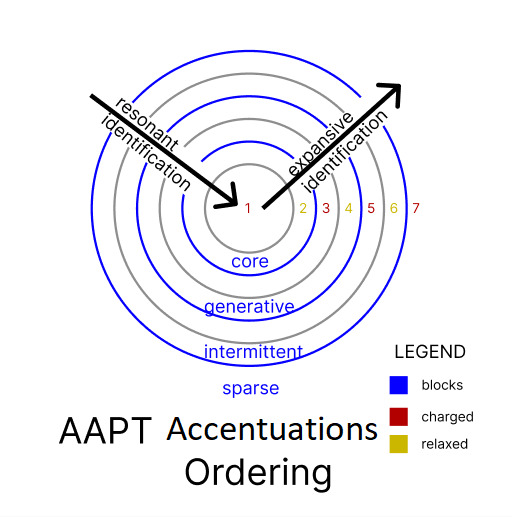
For those who are interested in interpersonal compatibility, in AAPT people have an AAPT dual which they can hypothesize, explore, and type. It can be homogeneous with one's own type or heterogeneous. It can really be any type. I've seen all kinds of unique complementary pairings. Authority Chain
The Authority Chain characterizes a bidirectional flow of consent and influence, with a Foundational end and an Executive end. In a duality or otherwise interaction of two people. The Aspiration towards the Foundational end has the role of accentuating sensitivities, pluripotent potentiality, and capacity for regrowth, insurrection and rebellion. In the integrated baseline sense Aspirations on the Foundational end support the capacity for connection, renewal, creativity, and freedom, and lead by embodying these values. Foundational aspirations have a bottom-up approach in these senses. The Aspiration towards the Executive end has the role of accentuating consolidating factors, path-finding, hosting and configuring spaces towards particular ends, and utilizing power. In the integrated baseline sense Aspirations on the Executive end support the capacity for efficacy, control, and intensification and collection of power. The Executive end embodies a top-down approach. In a duality or other desired interaction of two people, the person with the aspiration closer to the Foundational end is the Foundation, and the person closer to the Executive end will be referred to as the Executive. If the two people are the same aspiration, they will be referred to as identicals. At the same time I want people to keep in mind each interaction of two aspirations have unique qualities that have unique flavoring and potentials outside of the Authority Chain. Also, people who have integrated Aspirations are whole people who have the potential for interaction beyond this bi-directional pattern, and often times the positive capacities of each end will not be actualized, or done so in a toxic way if Aspirations are baseline unintegrated. Foundational <- I-M-C-F-H-V-S -> Executive Conclusion
I want to elaborate on how AAPT overlaps with gendered phenomena and the ways it doesn't. Gender norms often keep people from fully expressing who they are in an AAPT sense. And a lot of what gendered styles or presentations are communicating can be explained using AAPT. However, AAPT does not encapsulate what gender is entirely. It does articulate aspects of self that are often assigned to gender, particularly those related to power dynamics and softness or firmness.
AAPT is an affirmation of the body-neutral beauty that is in each person that emanates out in joyful, self-determined, powerful expression. I hope that AAPT can help people reflect on parts of themselves that are often policed or suppressed by society. I believe that the right self reflection frameworks can be an empowering tool to liberate oneself from shame-based expectations and gain agency. Additionally, resonating with these kinds of foundational ways of being in the world can be a source of joy and nourishment that unfortunately many people are disconnected from.
You're beautiful just because you are~ ✧・゚: *✧・゚:*:・゚✧*:・゚✧
#kibbe#queer#essence#personality theory#body neutrality#personality typology#aesthetic#aesthetics#enneagram#animix#socionics#attitudinal psyche#style#carl jung#gender#beauty
22 notes
·
View notes
Text
Intro to the Character Class System
Welcome to the Character Classification System! This is a personality system used to categorize patterns of behavior within characters across all forms of media. This system is broken down into six colors, which each character will possess three of. These colors are Red, Orange, Yellow, Green, Blue, and Indigo.
The Character Classification system proposes the belief that the differences in the values that a character prioritizes leads to diverging perspectives and subsequent behavioral patterns. In other words, the things we care about are determined by the people we are and the way we interact with others. These being: Nature, Experience, Direction, Structure, Sentiment, and Connection. Everyone wants all six, but it is the priority of importance in the eyes of the character that determines their class.
There are twenty classes in total. These are:
The Vagabond
The Warrior
The Sage
The Artist
The Tactician
The Warden
The Inventor
The Captain
The Dancer
The Merchant
The Athlete
The Judge
The Bard
The Knight
The Courier
The Jester
The Maestro
The Scholar
The Priest
The Lover
When presented with a situation, the character will most likely respond in accordance with their relevant colors. This response varies between the colors present of each individual classification, but presents itself as a natural baseline that a character will tend to rely on.
Now the real question: how is this helpful? Beyond identifying patterns of behavior in pre-existing characters, this system can be used as a template for new storytellers to create balanced and internally consistent characters from.
#characterclassificationsystem#ccs#character analysis#personality types#original character#character concept#character design#character personalities#16 personalities#enneagram#jungian archetypes#personality quiz#oc#ocs#typology#personality theory
23 notes
·
View notes